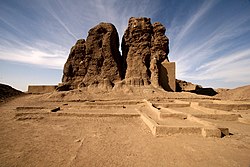 The temple in 2009 | |
| Location | Northern State, Sudan |
|---|---|
| Type | Temple |
| Height | c. 20 meters |
| History | |
| Material | Mudbrick |
| Founded | c. 2500 BC |
The Western Deffufa, located in the ancient city of Kerma in northern Sudan, is one of the oldest known monumental structures in the Nile Valley, dating back to at least 2500 BC. [1] [2] Rising about 20 meters (65 feet) high, it was built entirely from sun-dried mudbricks. Inside, the structure consists of a series of chambers and courtyards, thought to have been used for religious activities, rituals, and ceremonies central to the Kerma civilization. [3] The word "Deffufa" comes from the Nubian language, referring to buildings made of mudbrick, which were common Kerma’s architectural style. [4]
The Western Deffufa has been the focus of significant archaeological interest since its discovery in the early 20th century. Excavations led by Charles Bonnet and his team have revealed much of the site's layout and have uncovered numerous artifacts, including pottery, religious icons, and tools, all of which offer insight into the daily and spiritual life of the Kerma civilization. [5]
